Chełmża
Chełmża [ˈxɛu̯mʐa] (German: Kulmsee,[1] earlier Culmsee), is a town in Toruń County, Kuyavian-Pomeranian Voivodeship, Poland. It is located at around 53°11′5″N 18°36′15″E.
Chełmża | |
|---|---|
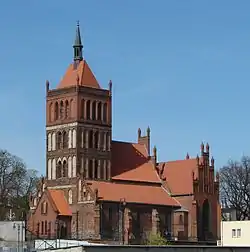 Saint Nicholas Church, built 13th–14th century. | |
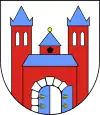 Coat of arms | |
 Chełmża | |
| Coordinates: 53°11′5″N 18°36′15″E | |
| Country | |
| Voivodeship | Kuyavian-Pomeranian |
| County | Toruń |
| Gmina | Chełmża (urban gmina) |
| Area | |
| • Total | 7.84 km2 (3.03 sq mi) |
| Population (2006) | |
| • Total | 15,273 |
| • Density | 1,900/km2 (5,000/sq mi) |
| Postal code | 87-140 |
| Website | http://www.chelmza.pl |
Geography
The town Chełmża is placed at the lake named Jezioro Chełmżyńskie (area 2.71 km²), earlier the lake itself was named Culmsee[2] and therefore eponym of the town[3], that earlier had the name Culmsee, too. (see History)
History
The first signs of settlement date to 10,000 BC when reindeer hunters made their visits to the area. Around 4500 BC the first agricultural settlements were founded.[4] Goth tribes also moved through the area on their trek from Scandinavia and North Germany. Visible signs of existence of the Old Prussians also exist. Around the 7th century Slavs (Goplans) arrived in the area.[4]
In the time of first Piasts and the formation of Poland, Ziemia Chełmińska and the settlement of Łoza (now the town of Chełmża) was incorporated into Chełmińska castellany.[4] After the death of Bolesław III Wrymouth in 1138 it was handed over to his son Bolesław IV the Curly – as part of Masovia.[4] The fights with nearby Old Prussian tribes resulted in several raids that destroyed the area. In the 13th century the ruler of the area was Konrad I who in order to Christianize the Old Prussians brought a missionary Bishop Christian of Oliva.[4] The bishop was granted a number of possession including the settlement of Łoza. Later Teutonic Knights were granted local lands to support the bishop by military means.[4] However, in time the knights took over the possession of Christian's diocese, dividing the area into four dioceses in 1243, including the Chełmińska diocese. At the end of 1245 Heidenreich of the Bishopric of Culm became the bishop of diocese. He picked Łoza as place of his stay. It was during that time that Łoza received its new name Culmense and became part of the residence of the bishop who resided and governed in Warmia from 1245 to 1263. In 1251 (before July 22) Bishop Heidenreich bestowed city rights to Łoza and renamed it Culmsee (Kulmsee).[5][6] A number of other towns are mentioned in his territory as well, such as Hermannysdorp, Arnoldisdorp, Sconenwerde, Belacin, Razlai, Zcampe, Heiminsod and Vambresin or Wambresin.
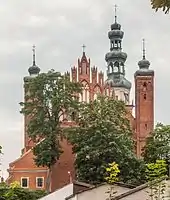
On July 22, the bishop also founded the cathedral which was built starting in 1254. Bishop Heidenreich received permissions for his undertakings directly from the pope. Later, in 1255 the four dioceses of Prussia, including the Bishopric of Culm were put under the jurisdiction of the Archbishopric of Riga as metropolitan.
In the 1250s Jutta von Sangerhausen came to live in Prussia and settled at Bielczyny. In 1256 she founded the St. George church. It was her wish to be interred at the Culmsee cathedral-church and upon her death in 1260 her wish was granted. The 5th of May is her memorial day. The nearby town of Bielczyny and the cathedral soon became a destination for pilgrims to her shrine.
The town witnessed many wars and uprisings. Local Old Prussians staged several sieges and raids. Additionally in the 15th century the town experienced the wars between Teutonic Knights and Poland.[4] In 1410 the Polish army took the town and the bishop of Chelmno Arnold Stapil made a tribute to Polish King Jogaila. In 1422 Chełmża was taken again by the forces of the king and destroyed in large part. After 1466 the town was integrated into Polish Kingdom.[4] In 1621 and 1627 the city hosted the court of Polish King Sigismund III Vasa along with Prince Władysław. The Swedish wars of 1626–29 and 1655–60 brought devastation to the town.[4]
In the beginning of the 18th-century Russian, Saxon, Swedish armies went through the area along with supporters of Stanisław Leszczyński. The constant warfare led to the fall of the city, and its breaking point was reached due a plague that happened in years 1708–1710.[4] A next series of wars in 1733–1735 and in 1756–1763 along with fire in 1762 almost completely destroyed the city.[4]
After first Partition of Poland on 15 September 1772 Chełmża was taken over by Kingdom of Prussia.At that time it counted only 600 inhabitants.[4] In 1807 till 1815 it became part of Duchy of Warsaw only to be taken over by Prussia again after 1815 and Congress of Vienna. The city population in 1831 counted 1,200 people and in 1871 3,000.[4] Its economic situation improved as it became an economic center for local villages benefited with good soil. During the Spring of Nations in 1848 Polish patriotism reinvigorated. Circle of Polish League was established and Polish newspaper "Biedaczek" is being distributed in the years 1849–1850 by Julian Prejs.[4]
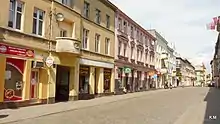
In 1866 “Towarzystwo Rolniczo-Przemysłowe” is created, an association dealing in industry and agriculture. In 1879 a regional court is established in Chełmża. Two banks and school are established as well. Jews, who made up 8% of local population, built in the 1880s a synagogue.[4] The industrial development was increased and agricultural manufacturing plant and railway terminal were completed in 1882. The population rose as well from 3,400 in 1880, 8,987 in 1900,[1] and 10,600 in 1910.[4] In 1869 a local church choir “Cecylia” was founded, which exists to this day. Around 1900, the town formed a language island of Swabian German.[7]
The development of the city was stopped due to the First World War. The living conditions declined and street riots became widespread. Poles rose up against Germanisation and protests were made against forced teaching in schools in German language.[4] On 8 January 1919 local Poles attacked a Grenzschutz unit but were repelled. In revenge the Germans shelled the town by artillery, and 7 random citizens were killed. Additionally several people were arrested upon suspicion of leading the protests.[4]
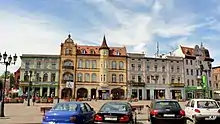
On 21 January as result of Treaty of Versailles, Chełmża became part of Poland again. A part of the German population was deported (2000 people). The population now counted 98% Poles, 1.8% Germans, 0.2% Jews. The overall number of Chełmża citizens rose from 10,700 in 1921 to 13,000 in 1939. After the Great Depression in 1929 wages became lower and unemployment rose. National Democrats and at the second place socialists led by Stanisław Nehring became the main parties in Chełmża.[4] “Gazeta Chełmżyńska” and “Głos Chełmżyński” were two papers distributed in the city. The mayor of the city was Bronisław Kurzętkowski from 1920 to 1933 and Wiktor Barwicki from 1933 till 1939.
After German invasion of Poland, extermination of the local Jewish population started. German state at the time considered Jews to be untermenschen and planned their eradication as national groups, including Poles. To escape this fate many locals took the III and IV group of Volksliste. As result of German repressions the population of the city declined to 10,000 in March 1945.[4]
In January 1945 the Red Army took Chełmża, thus ending the German occupation. Soviet repressions followed and 600 people of German descent were deported to Siberia. The losses inflicted by German occupation regarding the population were gradually reversed and in 1980 Chełmża counted 15,000 inhabitants.[4]
Famous residents
- Michał Czajkowski (born 1934), Polish priest and biblical scholar[8]
- Stefan Wincenty Frelichowski (1913–1945), Polish priest and patron of Polish Scouts, died of typhus at Dachau concentration camp
- Tadeusz Glemma (1895–1958), priest, professor, historian of Polish Catholic Church
- Michał Kwiatkowski (born 1990), Polish cyclist
- Jutta of Kulmsee aka Jutta von Preussen, Saint Judith, Saint Judith of Prussia or Jutta von Sangerhausen (1200–1260)
- Julian Prejs (1820–1904), Polish teacher and journalist
- Lothar Treuge (1877–1920), poet
- Kurt Vespermann (1887–1957), actor
- Eberhard Thunert (1899–1964), German general
- Józef Wrycza (1884–1961), Polish independence fighter and Catholic priest
- Kamil Demski (born 2003), Polish graphical designer
References
- Preussische Regesten, Ann.Thor.Chron.terre Pruss. Ss.r.Pr. III 59 468
- Urkundenbuch des Bisthums Culm, Latin: (Document record of Bishopric Culm/Kulm)
- Notes
- Chisholm, Hugh, ed. (1911). . Encyclopædia Britannica. 15 (11th ed.). Cambridge University Press. p. 944.
- Topographische Karte 2877 Culmsee 1:25000 Messtischblatt Deutsches Reich; Bundesamt für Kartographie und Geodäsie
- Chełmża
- "Historia Chełmży". Chełmża Urząd Miasta (in Polish). Archived from the original on December 19, 2008.
- Max Perlbach, Preussische Regesten [Prussian Documents: Ann. Thor. Chron. terre Pruss. Ss.r.Pr. III 59, 468)
- Urkundenbuch des Bisthums Culm
- Elard Hugo Meyer. Deutsche Volkskunde. BoD – Books on Demand. p. 303.
- http://lustronauki.wordpress.com/2009/01/02/michal-czajkowski/
External links
- Urkundenbuch des Bisthums Culm- Latin text of Culmsee (Culmensi)
- Online scan of Biedaczek, a polish newspaper published in 19th-century Chelmża
| Wikimedia Commons has media related to Chełmża. |

